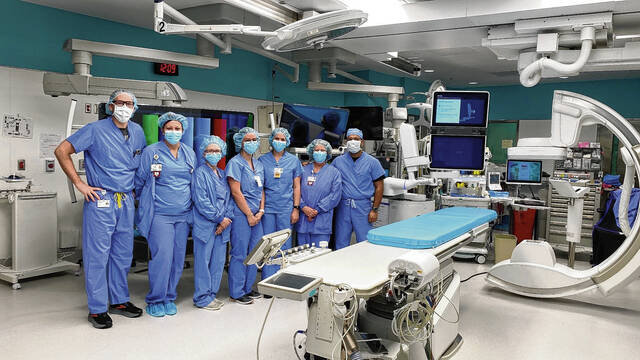
Pictured is the CRH team working with the Robotic Navigation and Cone Beam CT with Augmented Fluoroscopy to diagnose lung cancer earlier. Cone Beam CT Guided Robotic bronchoscopy will be a huge next step for the CRH pulmonary program, which is led by Lung Institute director and interventional pulmonologist Dr. Deepankar Sharma.
Columbus Regional Health has started using new technology that includes a human-controlled robotic arm in an effort to help detect and diagnose lung cancer — Bartholomew County’s top cancer killer.
The technology, which the hospital system started using Nov. 3, involves an assortment of tools that create a 3D map of the patient’s lungs and help doctors guide a catheter attached to a robotic arm through the narrow passageways of the lungs, said Dr. Deepenkar “Deep” Sharma, an interventional pulmonologist at CRH and director of the hospital system’s Lung Institute.
The robotic arm, which a doctor controls at a console next to the patient, allows doctors to reach hard-to-navigate areas inside the lungs in a less invasive way and perform biopsies on masses that were either previously too small or very difficult to reach.
The technology is Robotic Navigation and Cone Beam CT with Augmented Fluoroscopy, designed to diagnose lung cancer earlier.
So far, CRH has used to the new technology on about 10 patients with “great results,” said Sharma, who is optimistic that the new technology will play a key role in diagnosing a cancer that state records suggest is responsible for one in three cancer deaths in Bartholomew County.
Lung cancer killed 983 Bartholomew County residents from 1999 to 2019 — 318 more deaths than breast, colon and prostate cancers combined, according to the most recent data from the Indiana Department of Health. In 2019, 53 of the 161 cancer deaths in the county were attributed to lung cancer.
“The biggest hope with all this is to be able to identify lung cancer and other serious lung problems while they are still in early stages,” Sharma said. “…Survival is dependent on when you catch it.”
The launch of the new technology comes at as fears mount among local health officials that the pandemic disrupted screenings and other preventive care that may have caught cancers that before they reached later stages, when the chances of survival are far more uncertain.
It also comes after state health officials reported that lung cancer deaths in Bartholomew County rose 51% from 2017 to 2019, reaching the highest annual tally since 2012.
In 2019, 53 Bartholomew County residents died of lung cancer, up from 35 in 2017, according to state records released earlier this year. Data for 2020 is not yet available.
Though the impact of the pandemic on cancer care may not be fully known for some time, CRH has already seen an increase in cancer diagnoses so far this year.
About 18% of the 83 cancers detected through the hospital system’s lung cancer screening program since 2017 were found during the first six months of this year, according to figures provided by Sharma.
“We are definitely seeing more cancer diagnoses in 2021 due to the gap in care that happened due to the pandemic,” Sharma said.
Lung cancer is the nation’s biggest cancer killer and is expected to cause about 131,800 deaths this year, according to the American Cancer Society. Smoking is responsible for about 90% of lung cancer cases, according to the American Lung Association. At least 70 chemicals found in tobacco smoke have been found to cause cancer.
Yet most lung cancers are diagnosed too late for doctors to dramatically improve the chances of survival. Stage 1 lung cancer has a 90% survival rate, while stage 4 has a survival rate of less than 5%. But a patient can progress from stage 1 to stage 4 in just a few weeks, Sharma said.
Indiana has the eighth highest lung cancer rate in the country, according to a recent study by the American Lung Association. Just 7% of people Indiana who are at a high risk for lung cancer get screened and 1 in 5 Hoosiers with lung cancer never get treatment
CRH, for its part, has found a lung cancer prevalence rate through its screening program that is more than twice as high as the rate found in an authoritative national study of high-risk individuals diagnosed with the disease.
Since 2017, CRH officials have regularly seen a prevalence rate between 2% and 2.5%, compared to a national rate of about 1%, Sharma said. About 80% of local cases have directly or indirectly involved smoking.
“The last three years, we consistently have maintained twice the cancer incidence through our screening program,” Sharma said.
But many Bartholomew County residents who are at especially high risk can get an annual low-dose CT scan to detect lung cancer at an early stage when survival is far more likely. The screenings are non-invasive, painless and take around five minutes to complete, CRH officials said previously.
The U.S. Preventive Services Task Force recommends that anyone ages 50 and 80 who has smoked at least 20 “pack-years” and still smokes or has quit within the past 15 years, according to the Centers for Disease Control and Prevention. A “pack-year” means smoking the equivalent of one pack of cigarettes per day for a year.
Currently, CRH is on pace to perform more than 1,000 screenings this year, up from about 800 last year.
“In matter of a few weeks, you can go from being cancer-free forever versus not having even a year to live,” Sharma said.




